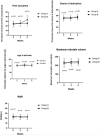Slow, deep breathing intervention improved symptoms and altered rectal sensitivity in patients with constipation-predominant irritable bowel syndrome
- PMID: 36408402
- PMCID: PMC9673479
- DOI: 10.3389/fnins.2022.1034547
Slow, deep breathing intervention improved symptoms and altered rectal sensitivity in patients with constipation-predominant irritable bowel syndrome
Abstract
Background and aim: Limited treatment options have been shown to alter the natural course of irritable bowel syndrome (IBS). Slow, deep breathing (SDB) is a common pain self-management intervention. This pilot study aimed to explore the impact of SDB on measures of autonomic and anorectal functions as well as patient-reported symptoms in constipation-predominant IBS (IBS-C).
Methods: Eighty-five IBS-C patients were enrolled in this study and randomly assigned to the experimental group (Group A, n = 42) and the control group (Group B, n = 43). SDB was conducted at six breathing cycles per minute with an inhalation for 4 s and exhalation for 6 s at a ratio of 2:3 and repeated for 30 min during the intervention. All subjects underwent high-resolution anorectal manometry (HRAM) and completed the standardized IBS symptom severity system (IBS-SSS) questionnaire. Meanwhile, changes in stool consistency, weekly frequency of complete spontaneous bowel movements (CSBMs), and weekly frequency of spontaneous bowel movements (SBMs) were recorded. All IBS-C patients received electrocardiogram (ECG) recordings for heart rate variability (HRV) analysis at baseline, weeks 3, 6.
Results: At baseline, no differences were found between Groups A and B. The IBS-SSS score and its five sub-scores of Group B patients were significantly higher at week 6 than those of Group A patients (all p < 0.001). Furthermore, compared with Group B patients, Group A patients had a significantly higher threshold volume for the first sensation (p < 0.001), desire to defecate (p = 0.017), and maximum tolerable volume (p = 0.018) at week 6 of the SDB treatment. We also noted significant improvements in stool consistency (p = 0.002), weekly SBM frequencies (p < 0.001), and weekly CSBM frequencies (p = 0.018) of Group A patients at week 6 when compared with Group B patients. Finally, the corrected high frequency (HF) of Group A patients was significantly higher than the HF of Group B patients at week 3 (p < 0.001) and at week 6 (p < 0.001). Likewise, patients in Group A had a significantly higher root mean square of the successive differences (RMSSD) than that of patients in Group B at week 3 (p < 0.001) and at week 6 (p < 0.001).
Conclusion: We found that a 6-week SDB intervention improved symptoms and altered rectal sensation in IBS-C patients. Moreover, SDB enhanced vagal activity. These findings suggest that the effect of SDB on IBS-C may be due to mechanisms involving autonomic responses.
Keywords: anorectal function; autonomic dysfunction; constipation; irritable bowel syndrome; slow deep breathing.
Copyright © 2022 Liu, Lv, Wang, Huang, Wang, Tian, Sun and Yu.
Conflict of interest statement
The authors declare that the research was conducted in the absence of any commercial or financial relationships that could be construed as a potential conflict of interest.
Figures




Similar articles
-
Transcutaneous Electrical Acustimulation Improves Irritable Bowel Syndrome With Constipation by Accelerating Colon Transit and Reducing Rectal Sensation Using Autonomic Mechanisms.Am J Gastroenterol. 2022 Sep 1;117(9):1491-1501. doi: 10.14309/ajg.0000000000001882. Epub 2022 Jun 10. Am J Gastroenterol. 2022. PMID: 35973183 Clinical Trial.
-
The effects of slow deep breathing on microvascular and autonomic function and symptoms in adults with irritable bowel syndrome: A pilot study.Neurogastroenterol Motil. 2022 May;34(5):e14275. doi: 10.1111/nmo.14275. Epub 2021 Oct 1. Neurogastroenterol Motil. 2022. PMID: 34595801 Clinical Trial.
-
Ameliorating effects and mechanisms of transcutaneous auricular vagal nerve stimulation on abdominal pain and constipation.JCI Insight. 2021 Jul 22;6(14):e150052. doi: 10.1172/jci.insight.150052. JCI Insight. 2021. PMID: 34138761 Free PMC article. Clinical Trial.
-
Effects of linaclotide in patients with irritable bowel syndrome with constipation or chronic constipation: a meta-analysis.Clin Gastroenterol Hepatol. 2013 Sep;11(9):1084-1092.e3; quiz e68. doi: 10.1016/j.cgh.2013.04.032. Epub 2013 May 2. Clin Gastroenterol Hepatol. 2013. PMID: 23644388
-
Biofeedback for treatment of irritable bowel syndrome.Cochrane Database Syst Rev. 2019 Nov 12;2019(11):CD012530. doi: 10.1002/14651858.CD012530.pub2. Cochrane Database Syst Rev. 2019. PMID: 31713856 Free PMC article.
Cited by
-
Research on the mechanism of core acupoints in electroacupuncture for functional constipation based on data mining and network acupuncture.Front Med (Lausanne). 2024 Dec 11;11:1482066. doi: 10.3389/fmed.2024.1482066. eCollection 2024. Front Med (Lausanne). 2024. PMID: 39722820 Free PMC article.
-
Effect of Pilates exercises on symptoms of irritable bowel syndrome in women: a randomized controlled trial.Arch Physiother. 2024 Dec 31;14:170-181. doi: 10.33393/aop.2024.3228. eCollection 2024 Jan-Dec. Arch Physiother. 2024. PMID: 39822393 Free PMC article.
-
Efficacy and Safety of Transcutaneous Auricular Vagus Nerve Stimulation in Patients With Constipation-Predominant Irritable Bowel Syndrome: A Single-Center, Single-Blind, Randomized Controlled Trial.Am J Gastroenterol. 2024 Dec 17;120(9):2139-2153. doi: 10.14309/ajg.0000000000003257. Am J Gastroenterol. 2024. PMID: 39689011 Free PMC article. Clinical Trial.
-
A primer for the gastroenterology provider on psychosocial assessment of patients with disorders of gut-brain interaction.Neurogastroenterol Motil. 2024 Dec;36(12):e14894. doi: 10.1111/nmo.14894. Epub 2024 Aug 12. Neurogastroenterol Motil. 2024. PMID: 39135459 Free PMC article. Review.
-
The effects of heart rate variability biofeedback on functional gastrointestinal disorders: a scoping review.Front Physiol. 2025 May 22;16:1511391. doi: 10.3389/fphys.2025.1511391. eCollection 2025. Front Physiol. 2025. PMID: 40476217 Free PMC article.
References
-
- American College of Gastroenterology Task Force on Irritable Bowel Syndrome, Brandt L. J., Chey W. D., Foxx-Orenstein A. E., Schiller L. R., Schoenfeld P. S., et al. (2009). An evidence-based position statement on the management of irritable bowel syndrome. Am. J. Gastroenterol. 104(Suppl. 1) S1–S35. 10.1038/ajg.2008.122 - DOI - PubMed
LinkOut - more resources
Full Text Sources
Research Materials
Miscellaneous

